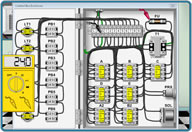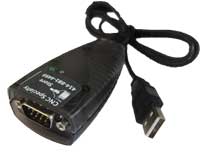The typical fixture hydraulic systems and operation
The hydraulic system used will obviously depend on many variables, but here is what I have found to be the most likely and useful configuration.
Fixed displacement pump hydraulic system with dump valve
Basic hydraulic system operation
Hydraulic pump sits at idle dumping over a dump valve to unload the pump. Clamp command is given and the dump valve is energized to prevent oil flowing directly to the tank. Once the clamps have been completed and pressure is at the maximum, the pressure switch actuates and shuts off the clamp solenoid and dump valve. Therefore, unloading the oil from the pump to tank. The clamps maintain pressure because of a P.O. check installed in the valve stack. If the P.O. check leaks or there is excessive leakage the hydraulic pump can be set up to perform a recharge though this is often not required. If a recharge is required the PLC will control the logic and dual setting pressure switches are needed for safety check. The first pressure switch set point will control the recharge point and the second will be the pressure at which will fault the machine if reached during the machining cycle. If the system recharges more then lets say 3 times in a minute, the system alarms out due to excessive cycling which can all be set up in the PLC. Unclamp and clamp circuits can both work under this concept though a recharge is not often needed for the unclamp. Single actuating and double actuating fixtures can be different to save costs, but this type of design setup should work for just about any fixture you would ever want to put on it.
Variable flow Compensator hydraulic systems
This type of system is generally a higher flow pump and much more costly. This system generally requires an oil cooler and flow control valves in the valve stacks, due to higher flow rates. These type of systems are also generally lower pressure systems, typically 2000 PSI or less.
Basic operation
These pumps have basically pistons attached to a plate. When there is a need for flow, the plate shifts increasing the stroke of the pistons and therefore it outputs more flow. This system always runs at full system pressure. When there is no oil flow there is no load because the plate with the pistons is vertical and there is no load. A relief valve is provided for safety but should never see any oil going over it in normal operation if set correctly. This type of system works well because it keeps constant pressure on the system and does not rely on P.O. checks holding pressure at the clamps. With this system you should still have P.O. checks incase the pump shuts off during the machining cycle.
Air over oil Pump systems
These systems are the cheapest of all systems. Depending on the brand and design you may have problems. They are very simple low volume/flow systems. They generally work well when using 2-4 valve stacks that are sequenced and do not require high volume of oil.
Basic operation
Air is supplied to the system. Air will cycle an intensifier type cylinder and push oil from a reservoir into the hydraulic system. Pressure is adjusted by adjusting the incoming air flow.
|





